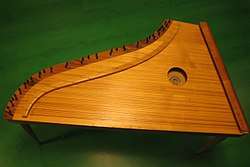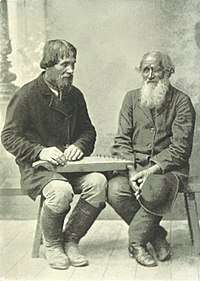Kannel (instrument)


Kannel ([ˈkɑnːel]) is an Estonian plucked string instrument (chordophone) belonging to the Baltic box zither family known as the Baltic psaltery along with Finnish kantele, Latvian kokles, Lithuanian kanklės, and Russian gusli. The Estonian kannel has a variety of traditional tunings. In Estonia, studying the kannel has made a resurgence after some years of decline.[1]
Etymology
According to Finnish linguist Eino Nieminen, the name of the instrument, along with most of its neighbouring counterparts (Finnish kantele, Latvian kokles and Lithuanian kanklės), possibly comes from a proto-Baltic form *kantlīs/*kantlēs originally meaning 'the singing tree'[2], ultimately deriving from the Proto-European root *qan- – 'to sing, sound'. However, Lithuanian ethnologist Romualdas Apanavičius believes the possible etymology of the hypothetical original form could be linked with the Proto-European root *gan(dh)- meaning 'a vessel; haft (of a sword)' also linking it with the Russian name gusli.[3]
History

The kannel became rare in the early 20th century, though surviving in some parts of the Estonian diaspora, until cultural movements under the Soviets encouraged the development and playing of larger chromatic kannels. However, influence from neighboring traditional Finnish kantele players supported the playing of the traditional smaller kannels.[4]
Social role
The kannel serves as a national symbol of Estonia; Jakob Hurt's 1875-1876 publication of Estonian folksongs was even entitled Vana Kannel ("The Old Kannel").[5] The kannel was legendarily played by the Estonian god of song Vanemuine, and the Estonian national epic Kalevipoeg (published in the 1850s) begins with the line: Laena mulle kannelt, Vanemuine! ("Vanemuine, lend me your kannel!").[6]
Players
See also
- Hiiu kannel, the Estonian bowed lyre
References
- ↑ Postimees: Pärimusmuusika ait lööb uksed valla (in Estonian)
- ↑ Williams, Roger, ed. (1993). "The Singing Tree". Insight Guides: Baltic States. APA Publications (HK) Ltd. p. 85. ISBN 978-9624-2118-2-5. Retrieved March 30, 2017.
- ↑ Simon Broughton; Mark Ellingham; Richard Trillo (1999). World Music: Africa, Europe and the Middle East. Rough Guides. pp. 18–. ISBN 978-1-85828-635-8. Retrieved 13 June 2012.
- ↑ David John Puderbaugh (2006). "My Fatherland is My Love": National Identity and Creativity and the Pivotal 1947 Soviet Estonian National Song Festival. ProQuest. pp. 50–. ISBN 978-0-542-83396-0. Retrieved 13 June 2012.
- ↑ Ethnologia Europaea. 1991. p. 139. Retrieved 13 June 2012.